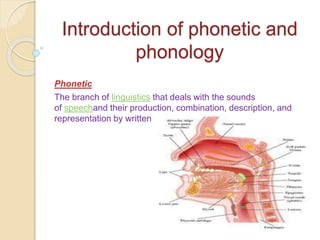
Pp31
- 1. Introduction of phonetic and phonology Phonetic The branch of linguistics that deals with the sounds of speechand their production, combination, description, and representation by written symbols
- 2. phonology the system of contrastive relationships among the speech sounds that constitute the fundamental components of a language.
- 3. Three branches of Phonetic Acoustic Phonetics This is the study of the sound waves made by the human vocal organs for communication and how the sounds are transmitted. The sound travels through from the speaker's mouth through the air to the hearer's ear, through the form of vibratio
- 4. Branches of phonetic Auditory Phonetics This is how we perceive and hear sounds and how the ear, brain and auditory nerve perceives the sounds. This branch deals with the physiological processes involved in the reception of speech. Articulatory Phonetics Articulatory phonetics is interested in the movement of various parts of the vocal tract during speech.The vocal tract is the passages above the larynx where air passes in the produc tion of speech.
- 5. Classification of sounds Traditionally, sounds are classified into consonants and vowels. Consonants are sounds that are produced with a major obstruction in the mouth cavity. For example, in the case of [t] (Fig. 1), there is direct contact between the tip of the tongue
- 6. Vowels sounds that are produced without such obstruction. For example, in the case of there is a gap within the mouth that is determined by the position of the tongue, and the airflow can escape relatively freely
- 7. Classification of consonants Factors relevant for the classification of consonants include the manner of articulation, the place of articulation, and voicing. With regard to the manner of articulation, English consonants can be classified into plosives, fricatives, affricates, nasals, liquids, and semivowels.
- 8. . bilabial plosives . [p] and [b] sound are involved
- 9. Alveolar plosives [t] and [d] are produced with the tip of the tongue firmly pressed against the (middle part of the) alveolar ridge. The active articulator is the tip of the tongue; the passive articulator is the alveolar ridge
- 10. Velar plosives [k] and [g] are articulated with the back of the tongue against the soft palate. The active articulator is the back of the tongue; the passive articulator is the soft palate. The back of the tongue makes firm contact with the soft palate. The air is trapped for a short time and then breaks the obstruction with a slight explosion.
- 11. Inter dental fricatives [θ] and [ð] The tip of the tongue is either close to the edge of the upper teeth or slightly projected between the teeth. For [θ] the friction is as strong as for [f], for [ð] it is gentler. For [θ] the vocal cords do not vibrate; they vibrate for [ð] when it occurs in word initial position, before a vowel or in intervocalic positions.
- 12. glottal fricative [h] It is produced with the voiceless expulsion of air from the lungs with the mouth and tonguealready in position for the following vowel
- 13. Affricates& Nasal Affricates are sounds that are similar to both plosives and fricatives: The tip of the tongue touches the back part of the teeth ridge, the front part of the tongue is raised towards the hard palate. Nasals are consonants which, like plosives, are produced by completely blocking the airstream. But there is an important difference: The airflow escapes through the nasal cavity(hence the term nasals). There are three nasal consonants in English: bilabial [m], alveolar[n], and velar [ŋ]:
- 14. Classification of vowels Depending on the height of the tongue, vowels can be classified into high, low, and mid vowels: When the front or the back of the tongue is raised towards the roof of the mouth, the vowel is called high, this is the case, e.g., in pill, meet, look, or soon. When the front or the back of the tongue is as low as possible, the vowel is called low, as, e.g., in land, star, or dog. When the tongue occupies the position intermediate between the high and the low one, the vowel is called mid, e.g. in get, or the unstressed [ə] in about
- 15. Diphthongs The vowels described so far have all been monophthongs, in contrast to the diphthongs (or gliding vowels), where the tongue moves from one position to another. Examples can be found in day, fight, oil, so, and now for the so-called closing diphthongs, while centring diphthongs occur, for example, in bare, beer, and sure.
- 16. Allophones Some sound differences do not differentiate meaning, as in the pronunciation of /l/ in thewords lip and pill. While the difference may be only slight (you may try to keep track ofwhere you place the tip of your tongue), from a phonetic point of view the two realizations of/l/ have to be considered two phones,
- 17. Syllables Phonology does not only describe a system of sounds in isolation, but it also deals with the rules and restrictions that hold for their combinations. This branch of phonology is called phonotactics. Phones combine into the syllable, which is essentially a vowel with optional consonants clustered around it
- 18. Prosody Prosody belongs to the domain of suprasegmental phonology in that it describes phenomenaextending over more than one phoneme. The phenomena that belong here are stress, rhythm,and intonation. While stress can be word or sentence stress, rhythm and intonation occur in phrases and sentences. Intonation is described by reference to pitch (tones); different levelsof pitch are used to express a wide range of meanings
- 19. NAME SADIA TAHIR TOPIC: PHONETIC &PHONOLOGY UNIVERSITY OF ENGINEERING AND TECHNOLOGY